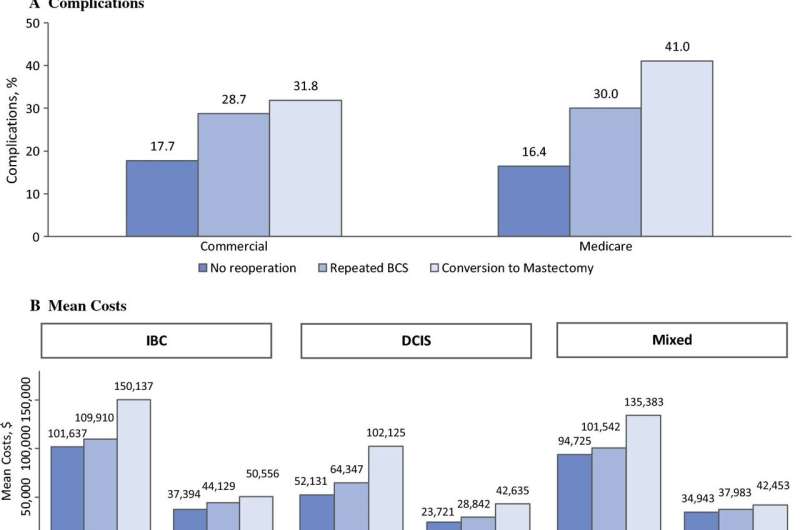This article has been reviewed according to Science X's editorial process and policies. Editors have highlighted the following attributes while ensuring the content's credibility:
fact-checked
trusted source
proofread
Re-excision rates after breast-conserving surgery pose ongoing challenges, high reoperation rates and costs

Rates of re-excision after initial breast-conserving surgery in women with breast cancer remain high across the United States, leading to an increased cost of care and a higher risk of postoperative complications, according to new research from UTHealth Houston.
The study, led by first author Youngran Kim, Ph.D., assistant professor; and senior author Trudy Krause, Ph.D., professor, was published in Annals of Surgical Oncology. Both are with the Center for Health Care Data in the Department of Management, Policy and Community Health at UTHealth Houston School of Public Health.
"Using commercial insurance claims and Medicare data, the study has unveiled critical insights into reoperation rates and associated health care costs for patients undergoing breast-conserving surgery," Kim said. "After undergoing initial breast-conserving surgery, one in five commercially insured women and one in seven enrolled in Medicare experience reoperation, according to our research."
Breast cancer is the second most common cancer in women and accounts for one in three new female cancers in the United States. Breast-conserving surgery is typically recommended to patients to remove cancerous tissue along with a surrounding margin of healthy tissue while preserving as much of the breast as possible. However, if cancer cells persist at the surgical margins, additional operations may be required.
Despite consensus guidelines released in 2014 by the Society of Surgical Oncology-American Society for Radiation Oncology on surgical margins for breast-conserving surgery, the study highlights a persistent high reoperation rate.
"Previous studies reported a significant decrease in reoperation rates immediately after the publication of the guidelines, but there was no evidence of further reduction observed in subsequent years. The purpose of this study was to provide a more comprehensive and current understanding of reoperation rates and health care costs associated with reoperation for patients who underwent breast-conserving surgery at the population level," Kim said.
The research team identified 17,129 commercially-insured women ages 18–64 and 6,977 Medicare beneficiaries age 18 and older who had initial breast-conserving surgery between 2017 and 2019. The one-year follow-up revealed reoperation rates of 21.1% among commercially-insured women and 14.9% among the Medicare cohort.
These reoperations correlated with a 24% increase in costs for both the commercial and Medicare cohorts, translating into incremental expenses of $21,607 and $8,559, respectively. Furthermore, reoperations were linked to a 54% increased risk of complications in the commercial cohort and an 89% elevated risk in the Medicare cohort.
"Our findings underscore the persistence of high reoperation rates after breast-conserving surgery, contributing significantly to increased health care costs and adverse outcomes," Kim said.
The study also found that younger age and ductal carcinoma in situ were associated with a higher reoperation rate, while the use of neoadjuvant chemotherapy and immediate oncoplastic surgery were associated with a lower reoperation rate.
"Accounting for instances in which extent of disease might be underestimated on the imaging findings and other such factors that may lead to a positive margin on final pathology, ideally the reoperation rates should be closer to 5%," said Nina Tamirisa, MD, contributing author and assistant professor in the Department of Breast Surgical Oncology at The University of Texas MD Anderson Cancer Center.
"Improvements in the intraoperative assessment of margins should be utilized to mitigate the risk of additional surgery and improve delivery of breast cancer care."
More information: Kim, Y., et al. Contemporary Analysis of Reexcision and Conversion to Mastectomy Rates and Associated Healthcare Costs for Women Undergoing Breast-Conserving Surgery. Annals of Surgical Oncology (2024). DOI: 10.1245/s10434-024-14902-z




















